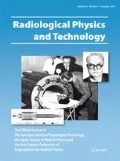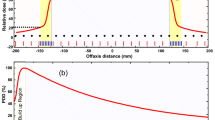Abstract
Intensity-modulated radiation therapy (IMRT) requires a patient-specific quality assurance (QA) program to validate the treatment plan and a high level of dosimetric accuracy in the treatment delivery. Dosimetric verification generally consists of both absolute- and relative-dose measurements in a phantom using ionization chambers. Measurements were carried out with three different ionization chambers (Scanditronix FC 65G, Exradin A18, and PTW PinPoint 31014) to assess the effects of influence quantities such as the stability, pre- and post-irradiation leakage, stem effect, polarity, and ion recombination on the IMRT point-dose verification with two different orientations. The Exradin A18 and PTW PinPoint ion chambers demonstrated noticeable leakage to magnitudes of 0.6 and 1.2%, whereas negligible leakage was observed with FC 65G ion chamber. Maximum deviations of 0.5 and 0.6% were noticed for the smallest field owing to the ion recombination effect with the PTW PinPoint ion chamber in the parallel and perpendicular orientations, respectively. The calculated total uncertainties of all influence quantities for the FC 65G, A18, and PTW PinPoint ion chambers were 0.5, 0.7, and 1.3%, respectively. The uncertainties determined for each chamber were incorporated into the point-dose measurements of 30 head and neck patient-specific QA plans, and the variation was found to be within ±3%. The magnitude of the leakage in a small-volume ion chamber indicated the significance of incorporating the correction factors in the absolute-dose measurement. A paired t test analysis indicated that the influence quantities significantly affect the point-dose measurements in the patient-specific IMRT QA.






Similar content being viewed by others
References
Low DA, Parikh P, Dempsey JF, et al. Ionization chamber volume averaging effects in dynamic intensity modulated radiation therapy beams. Med Phys. 2003;30(7):1706–11.
Kumar R, Sharma SD, Deshpande S, et al. Analysis of patient specific dosimetry quality assurance measurements in intensity modulated radiotherapy: a multi centre study. J Cancer Res Ther. 2014;10(3):611–7.
Hunt MA, Zelefsky MJ, Wolden S, et al. Treatment planning and delivery of intensity-modulated radiation therapy for primary nasopharynx cancer. Int J Radiat Oncol Biol Phys. 2001;49(3):623–32.
Chao KS, Low DA, Perez CA, et al. Intensity-modulated radiation therapy in head and neck cancers: the Mallinckrodt experience. Int J Cancer. 2000;90(2):92–103.
McKenzie EM, Balter PA, Stingo FC, et al. Reproducibility in patient-specific IMRT QA. J Appl Clin Med Phys. 2014;15(3):241–61.
Sánchez-Doblado F, Capote R, Leal A, et al. Microionization chamber for reference dosimetry in IMRT verification: clinical implications on OAR dosimetric errors. Phys Med Biol. 2005;50(5):959–70.
Verellen D, Linthout N, van den Berge D, et al. Initial experience with intensity-modulated conformal radiation therapy for treatment of the head and neck region. Int J Radiat Oncol Biol Phys. 1997;39(1):99–114.
Chang J, Mageras GS, Chui CS, et al. Relative profile and dose verification of intensity-modulated radiation therapy. Int J Radiat Oncol Biol Phys. 2000;47(1):231–40.
Bogner L, Scherer J, Treutwein M, et al. Verification of IMRT: techniques and problems. Strahlenther Onkol. 2004;180(6):340–50.
Fraser D, Parker W, Seuntjens J. Characterization of cylindrical ionization chambers for patient specific IMRT QA. J Appl Clin Med Phys. 2009;10(4):241–61.
Sánchez-Doblado F, Andreo P, Capote R, et al. Ionization chamber dosimetry of small photon fields: a Monte Carlo study on stopping-power ratios for radiosurgery and IMRT beams. Phys Med Biol. 2003;48(14):2081–99.
Martens C, De Wagter C, De Neve W. The value of the PinPoint ion chamber for characterization of small field segments used in intensity-modulated radiotherapy. Phys Med Biol. 2000;45(9):2519–30.
Sánchez-Doblado F, Capote R, Roselló JV, et al. Micro ionization chamber dosimetry in IMRT verification: clinical implications of dosimetric errors in the PTV. Radiother Oncol. 2005;75(3):342–8.
Low DA, Mutic S, Dempsey JF, et al. Quantitative dosimetric verification of an IMRT planning and delivery system. Radiother Oncol. 1998;49(3):305–16.
Leybovich LB, Sethi A, Dogan N. Comparison of ionization chambers of various volumes for IMRT absolute dose verification. Med Phys. 2003;30(2):119–23.
Syam Kumar SA, Sukumar P, Sriram P, et al. A patient-specific quality assurance study on absolute dose verification using ionization chambers of different volumes in RapidArc treatments. Med Dosim. 2012;37(4):436–41.
International Electrotechnical Commission IEC-60731. Medical electrical equipments—dosimeters with ionization chambers as used in radiotherapy. Geneva. 2011.
Kweon DC. An Overall Stem Effect, including Stem Leakage and Stem Scatter, for a TM30013 Farmer-type Chamber. J Korean Phys Soc. 2011;58:1688–96.
Andreo P, Burns DT, Hohlfeld K, et al. Absorbed dose determination in external beam radiotherapy: an International Code of Practice for dosimetry based on standards of absorbed dose to water (IAEA Technical Reports Series No. 398) 2000.
Agostinelli S, Garelli S, Piergentili M, et al. Response to high-energy photons of PTW31014 PinPoint ion chamber with a central aluminum electrode. Med Phys. 2008;35(7):3293–301.
Stasi M, Baiotto B, Barboni G, et al. The behavior of several microionization chambers in small intensity modulated radiotherapy fields. Med Phys. 2004;31(10):2792–5.
Williams JA, Agarwal SK. Energy-dependent polarity correction factors for four commercial ionization chambers used in electron dosimetry. Med Phys. 1997;24(5):785–90.
Shimono T, Koshida K, Nambu H, et al. Polarity effect in commercial ionization chambers used in photon beams with small fields. Radiol Phys Technol. 2009;2(1):97–103.
Elawady RA, Attalla EM, Elshemey WM, et al. Dose verification of intensity modulated radiotherapy in head and neck tumors. Int J Cancer Ther Oncol. 2014;2(3):02037.
Fenoglietto P, Laliberté B, Aillères N, et al. Eight years of IMRT quality assurance with ionization chambers and film dosimetry: experience of the Montpellier Comprehensive Cancer Center. Radiat Oncol. 2011;6:85.
Kumar A, Mukherjee G, Yadav G, et al. Optimized point dose measurement: an effective tool for QA in intensity-modulated radiotherapy. J Med Phys. 2007;32(4):156–60.
Jang SY, Liu HH, Mohan R. Underestimation of low-dose radiation in treatment planning of intensity-modulated radiotherapy. Int J Radiat Oncol Biol Phys. 2008;71(5):1537–46.
Xing L, Curran B, Hill R, et al. Dosimetric verification of a commercial inverse treatment planning system. Phys Med Biol. 1999;44(2):463–78.
Agazaryan N, Solberg TD, DeMarco JJ. Patient specific quality assurance for the delivery of intensity modulated radiotherapy. J Appl Clin Med Phys. 2003;4(1):40–50.
Acknowledgements
The authors are grateful to Dr. Jasmine Prasad for her valuable contribution towards the statistical analysis. We would also like to thank Dr. Shwetha for her support in this study. The contribution of Mr. Muhammed Shafeeque, Mr. Arun and Mr. Paranthaman towards the measurements on Linear Accelerators is greatly appreciated.
Author information
Authors and Affiliations
Corresponding author
Ethics declarations
Conflict of interest
None.
About this article
Cite this article
Godson, H.F., Manickam, R., Saminathan, S. et al. The effect of influence quantities and detector orientation on small-field patient-specific IMRT QA: comparison of measurements with various ionization chambers. Radiol Phys Technol 10, 195–203 (2017). https://doi.org/10.1007/s12194-016-0385-y
Received:
Revised:
Accepted:
Published:
Issue Date:
DOI: https://doi.org/10.1007/s12194-016-0385-y




